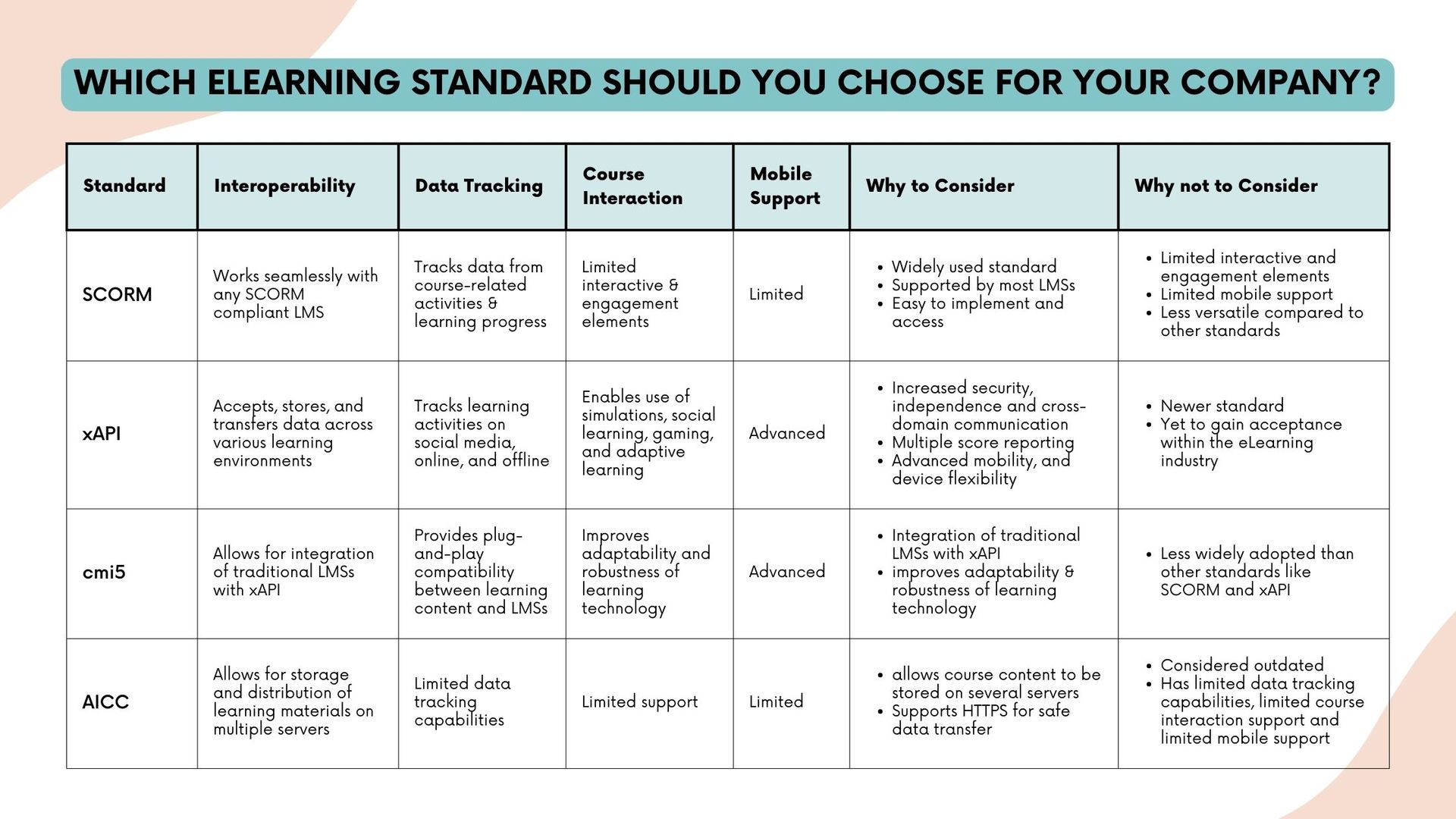Create Effective Programs With eLearning Standards
When it comes to eLearning, Learning and Development (L&D) managers often face a number of pain points in their efforts to ensure effective training and management for their organization. These can include determining the most relevant eLearning standards, ensuring compatibility between content authoring software and Learning Management Systems (LMSs), managing the cost and effort involved in creating and delivering eLearning content, and ensuring accessibility for all learners. Additionally, keeping up with the constantly evolving eLearning landscape can also present a challenge. Despite these difficulties, L&D managers can take steps to navigate these pain points and create effective eLearning programs that meet the needs of their organization.
What Is An eLearning Standard?
Standards are a common and widely-used concept across various industries and aspects of daily life. They refer to a repeatable, agreed-upon, and documented method of performing a task or achieving a specific outcome. Standards can be found in a wide range of areas, from the food we consume to the batteries we use to power our devices.
Have you ever used USB drives to transfer files? You can plug a USB drive into any computer, whether it is a Mac or a PC, and it will work, because USB drive manufacturers adhere to a set of standards. This feature of interoperability allowed for compatibility across different operating systems and types of computers.
Just as a set of standards can impact various industries, a set of eLearning standards have played a crucial role in driving the eLearning industry forward. In this post, we will explore the popular eLearning standards available, delving into their features and benefits. We will also evaluate which standards are considered the best for specific needs and goals.
What Is SCORM?
SCORM, or Shareable Content Object Reference Model, is a set of technological standards developed in 2000 by the ADL (Advanced Distributed Learning), an organization within the US Department of Defense. It has become a widely-used industry standard for eLearning and promotes interoperability between eLearning courses and the platforms on which they are hosted.
SCORM-compliant courses can be created and published using eLearning authoring tools, and can be found in zip folders on any SCORM-compliant LMS. With SCORM, you can track the status and compatibility of your eLearning course, as well as the completion status, assessment scores and percentages, and the number of points earned by users. You can also see how many times a user has accessed a course and present them with certificates.
Over time, SCORM has evolved, and it is now available in four different versions, with the most recent being the Experience API (xAPI). However, it is important to note that SCORM is not the only eLearning standard available; other standards like AICC, HACP and xAPI also have their place in the eLearning domain.
What Are The Different eLearning Standards?
1. SCORM
SCORM is available in several different versions, each with its own unique features and capabilities. Here's a quick rundown of the options available:
- SCORM 1.1
This was the first version of SCORM, but it was not widely adopted. - SCORM 1.2
This version addressed many of the issues present in the previous version, and is the most widely used version. It is supported by all types of LMS. - SCORM 2004
This version has four different editions, each released to address specific requirements:
-
- The first edition, which is not fully implementable, was released in January 2004, and can be used as a self-maintaining version.
- The second edition, released in July 2004, introduced new features such as the content aggregation model and the run-time environment.
- The third edition, released in October 2006, is the most commonly used version of the interaction sequence between content and the run-time environment. Additional compliance standards were implemented to improve its compatibility.
- The fourth edition, released in March 2009, simplifies the course development process and allows for easier production of sequenced material. It also includes additional features for content producers, and a new certification method for addressing LMS-related issues.

2. xAPI
The Experience API (xAPI) or Tin Can API, is a modern standard that provides guidelines for the transfer and storage of data. It allows for the collection of data from different sources (not just eLearning courses), such as team-based learning activities, simulations, mobile learning, and electronic games. Records of learner or team activities are transmitted to a Learning Record Store (LRS) which can share transcriptions with other LRS, and can exist within an LMS or separately.
Unlike SCORM, which only works with compatible LMSs, the Experience API can accept, store, and transfer data across multiple learning environments using Learning Record Stores. It can track learning activities on social media, online, and offline, and the LRS can be an independent component or included in the LMS.
In addition to the benefits of SCORM, the Experience API offers increased security, independence, cross-domain communication, advanced mobility, and device flexibility thanks to the LRS. It also allows for the integration of interactive elements such as simulations, social learning opportunities, gaming scenarios, and adaptable learning experiences. When choosing to publish your courses to any of these standards, it is important to ensure that the LMS where you plan to store your online training courses is compatible with that standard.
3. cmi5
Cmi5 is a standard that can be used to integrate traditional Learning Management Systems with the xAPI. It ensures that learning content and LMSs are plug-and-play compatible, as the xAPI feature is very general and allows a wide range of use cases.
The AICC (Aviation Industry Computer-Based Training) launched cmi5 in 2010. Cmi5 was designed to replace both the AICC and SCORM standards with more features and resilient solutions. Both the AICC and SCORM standards had technical challenges and limitations, and overlapped with each other. In 2012, as the ADL's Tin Can API research project (now known as xAPI) was ending, the AICC was completing cmi5's SOAP-based communication mechanism.
Participants from the AICC and ADL soon realized that the two standards had many similarities. ADL and AICC decided to work on an xAPI profile to fulfill cmi5's more specific use case criteria, and now xAPI has a broader application than cmi5. The cmi5 project underwent a revamp in 2012, swapping out the SOAP design for xAPI. In 2014, the AICC was disbanded, and the cmi5 project was handed over to the ADL.
4. AICC
AICC was a non-profit international organization of technology-based training experts, credited with developing the first guidelines for eLearning. The organization developed technical standards to facilitate the development, delivery, and evaluation of training materials across computer-based training platforms that can be employed by any industry for their online courses. AICC HACP is used by AICC to permit communication between an eLearning course and an LMS.
To host and distribute material, LMSs or learning platforms must be AICC-compliant and comply with at least one of AICC's nine criteria and recommendations. Initially, these guidelines were exclusively used for CD-ROM-based training, but in 1998 they opened up to embrace web-based training.
While AICC is considered outdated, there are still some reasons to ensure that courses and LMSs meet its requirements. AICC allows for the distribution of course materials across multiple servers and utilizes secure HTTPS protocol for the transfer of data. However, it has limited capabilities, as it cannot track progress in the course and retrieving data from the LMS can be cumbersome.
How Can A Good eLearning Vendor Help?
Ranjana, an experienced L&D manager, at a large multinational corporation, was facing a problem. Her company had a diverse workforce spread out across multiple locations and time zones, making it difficult for her to accurately track the progress and engagement of her employees in the eLearning courses she had designed for them. Determined to find a solution, she reached out to an eLearning solution expert for guidance. After discussing her specific needs and challenges, the expert recommended that she implement the xAPI standard in her company's eLearning program.
The expert explained that xAPI is designed to accept, store, and transfer data across various learning environments, making it perfect for her situation as it would allow her to track learning activities on both online and offline platforms, including social media and other external sources. Additionally, xAPI enables use of simulations, social learning, gaming, and adaptive learning, providing a more engaging experience for her employees.
Ranjana was impressed with the solution and quickly implemented xAPI in her company's eLearning program. With the new standard in place, she was finally able accurately to track the progress and engagement of her employees, allowing her to make data-driven decisions to improve her training program. Feeling confident in her decision, she reached out to the expert to express her gratitude and to say that xAPI was the perfect solution for her problem, and that it had exceeded her expectations.
Which eLearning Standard Should You Choose For Your Company?

Parting Thoughts
eLearning is a versatile and effective method of training that can be used to convey information on a wide range of topics. Its goal is to impart knowledge and assist learners in solving issues at work by using their newly gained skills and knowledge. However, as an L&D manager, it is crucial to ensure that your eLearning courses are compliant with industry standards, such as SCORM, to ensure that your course development efforts do not go to waste.
When considering the implementation of a new Learning Management System or upgrading an existing one, it is essential to conduct a thorough analysis of your organization's needs, learner demographics, and expectations. This will ensure that your organization's eLearning efforts align with your goals and objectives.
Image Credits:
The images/infographics within the body of the article have been created and supplied by the author.










